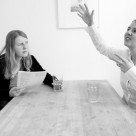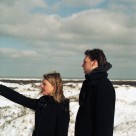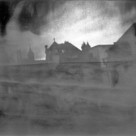Why do you produce unique prints? Photography does not usually mean that one produces only one copy of each photo. One of the greater values of photography is the possibility of duplication. Why do you choose not to use this benefit?
The value of a photograph is important to me. Doesn’t my art lose its value if I create it as mass-production? Multiplication is only necessary for profit. When it comes to creating my work, multiplication is of no interest to me. If you would still have ten other ice-cream Popsicle in the fridge, the one you’re eating would lose it’s meaning. You could eat another one, and another one, until you are sick. My art should work in the same way. The viewer should experience my work, and notice it. One shouldn’t be sick of it. One should say: „Do you remember when we saw those Ina Marie Schmidt artworks? That was an experience! Some images are still stuck in my mind!“
So, what happens when you happen to sell one of your works? It will be accessible to only a very small group of viewers, and nobody will know what kind of an experience they’re missing out on!
Yes, that is a problem indeed. There is always the possibility to create two almost identical images. One of the images should then remain unsold. It might sound somewhat strange, but it is only logical. With such ideas, I feel like a true German. Ordnung muss sein. Order must be, and I have to stick to my fundamental principles.
Or, the buyer of the work should sign a contract, in which he allows the work to be exhibited at any time and any date. He will then have to make sure the work is not damaged. So he can’t put it in the garden where it will be damaged because of moisture and such. I could maybe rent out the works, for a limited amount of time. That would mean they will always remain my property. Or I can just never sell them at all. When it comes to this subject, I am somewhat lost in the woods. There are many possibilities, but very little are easy to realize, and most even have to be legally secured to be useful. I think it’s more important for me to continue working on my art than to dress-up and play business-woman.
Basically, every new edition is a unique print. Every work is produced by me personally, in the dark room. The situation is not always the same, which also makes every print unique. Sounds strange maybe, but it’s true.
And by the way, what would it be like if someone could not sleep at night anymore because one of my prints is missing over his bed? I can’t just take the thing away and point to some contract?
There are consistent solutions, that work without emotions and probably costing a lot of time and money, and there are practical solutions, which are the easiest for now.
I think my work will have a rather small audience anyway. And what’s more important? Selling the work or showing it to even more people?
So you rather would not sell your art?
Yes, correct. Of course it’s nice to sell a work, but only for that first instant. It’s a kind of praise, a confirmation, a thanks. Money is the currency of recognition and respect. But actually words can do exactly the same, as well as conversations with interested viewers. Basically an art-work is priceless. But on the other hand, it would be good if one could make a living doing this, making art. It is supposed to be my job, after all.
Why don’t you paint? Or use another medium which is not so easily duplicated? That seems like a logical step.
Maybe later, when I’m tired of photography, when I’ve tried and tested everything. Currently I am also drawing, I’m even making small sculptures, but somehow I am not completely convinced of this work yet. I must admit I often think about it, what my work would look like when I would use another medium. Who knows, maybe in twenty years I’ll throw my camera equipment out of the window and find myself before a canvas. When I would flip a certain switch in my mind, I would probably be able to work with any technique. But I don’t feel like that right now. Of course it’s also about having fun doing the work, otherwise I would have chosen another job a long time ago.
What fascinates me in photography is the boundaries of the technology. I think that in painting I would be lost in all those possibilities. Photography is simple and easy. One is caught in it’s laws, so to speak. The materials invite experiment and testing. Photography captures reality. It displays „reality“. In this case, reality means shape, not content. We see a tree and it actually is a tree, a real tree.
In this reality, there are elements which are real, but lose their reality because of my intervention. It could be the location, a strange, unreal place. Or it could be the gestures and expressions of the photographed people. Everything seems normal and natural, but somewhere there is an exaggeration which questions the reality of the whole picture. I try to reach the limits of what we perceive as real and subtly cross the border to what we find surreal. Just a little bit more, and my work would perhaps be a crude joke.
This seems a typical theme in photographic art. What about the content, what kind of themes and concepts lie below the surface of your work?
Art is always a self-portrait. In my work you can see that very clearly, since I am personally present in most of it. Self-confident and (apparently) conscious of the situation I and my models appear in the image. But the situations in which we pose are sometimes very exaggerated, even though maybe in a subtle way. I try to display stubbornness and willfulness, and then to moderate it again. The world would be a better place if people stopped taking themselves so seriously. Put very simple, I ask questions. I create my own answers, my own truth, and doubt it at the same time.
It seems that there are some references to history in your work? In the series „Gesellschaftsspiel“ you pose at a war monument, or you stand on top of a former bunker from the Second World War.
Grotesque historical examples are everywhere. The bunker, called the „Wassermann“, is located on the Dutch isle of Schiermonnikoog. It has a very suspect history. It was originally designed to form a part of the Atlantic defense wall which the Germans created as a protection for a possible invasion. It was supposed to be the location of a radar system, but sabotage resulted in the project never being finished. After WWII it was converted into a bar. That didn’t go so well, and now it’s a viewpoint for (German) tourists. What I’m trying to point out in my work is the delusion we are creating in our heads. The delusion is we think we know everything and that we are better than our neighbors. Everything we do, we do better than the others. This arrogance, and the pretension of knowledge and ability, fascinate me. Basically we are all petty liars, who talk everything right for themselves. We look for truth, and we are to pigheaded to admit there is no such thing. For the series „Gesellschaftsspiel“ goes: „Isn’t there a little Adolf Hitler in all of us?“
Where does the title „Gesellschaftsspiel“ (board-games) come from? What is your interest in board-games?
The title came into being when me and a friend were thinking about creating a photo-series together. We wanted to combine social criticism and self-irony. We didn’t complete this photo-series, but this theme kept fascinating me. So I continued alone. This theme regularly surfaces in my work.
Board-games are very weird for me. At our home there weren’t many of them, and when so, they were only standing in the cupboard. I always liked playing without set rules much better. I liked to make my own rules.
Everybody knows of situations in which he praises himself and ‚forgets‘ his weaknesses. Small lies, those I try to capture and record, by means of very mundane examples. Hypocrisy preferred.
What are you currently doing? What are your plans for the future?
Currently in my art I work with very long exposure times. I work with several types of Camera Obscura, and in September I will transform a 20 foot cargo-container into a large pinhole camera. I will create photographs with this camera for a month, in various locations. I want to create true unique prints. I will use reverse photographic paper, and perhaps also larger formats. Usually I’ve only used small paper. I will also apply for a Master of Arts programme, because I miss interactions with other artists and experts from the art world. A master programme also offers me the room and the time to focus on my work. I would really like to work together with motivated people like me, and learn how they work. I think this will help me position my work in contemporary art.
Technically, I want to expand the production of camera systems and lenses, and continue experimenting with them. I want to find the borders of photography.
Thematically one of my projects is the former inner German border. The border between East- and West-Germany. I planned a trip along this border, and I will go on a search for traces of this history. Where can I still find evidence of the existence of this border, and how did it influence daily life? What does a village look like that has been split up by a wall for years? Which grotesque situations did it create?
Hamburg, May 11, 2008


